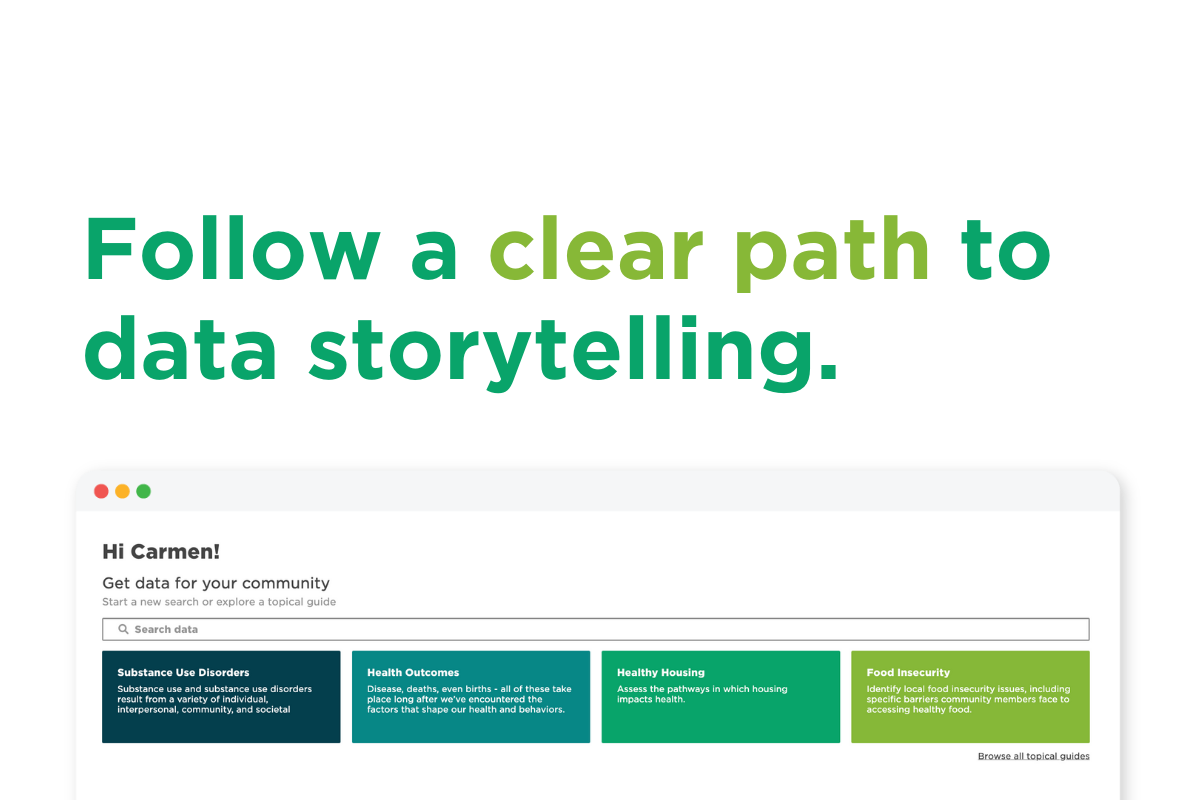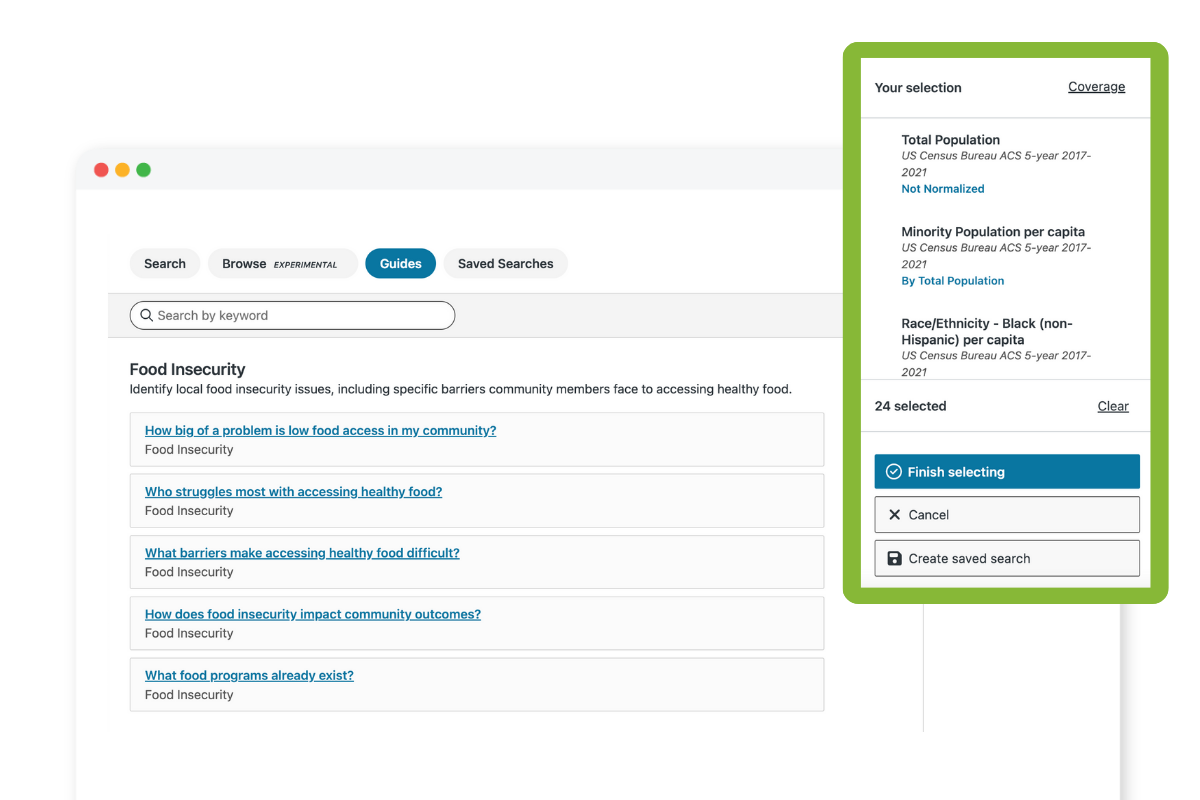8 Things to Understand About Food Insecurity and How Data Storytelling Helps Us Find Solutions
Food is more than just sustenance; it is a fundamental human right and a source of comfort, culture, and community. Yet, across the country, millions face the harsh reality of food insecurity. Not only does the issue threaten physical and mental health outcomes but it also undermines the social fabric of communities and hinders the growth and development of families and children. However, together—and through engaging community data stories, we can gain a deeper understanding of the issue and build a stronger, more food-secure future for all.
In the battle against food insecurity, public leaders and organizations play a pivotal role in understanding, addressing, and sharing information about its contributing factors and impacts. In efforts to create meaningful change, communities are harnessing the power of community data with mySidewalk's data library and storytelling tools. By having reliable information you can trust and using data-driven narratives, we can help you paint a vivid picture of the challenges faced by communities, families, and children experiencing by food insecurity.
How can we really understand food insecurity?
Food insecurity is a complex issue that demands a comprehensive understanding of its causes and consequences. It encompasses much more than the physical discomfort of hunger; it takes a social, economic, and emotional toll on individuals and communities.
Contributing Factors to Food Insecurity
1. Poverty: It is overwhelmingly true that poverty lies at the core of food insecurity, leaving individuals and families unable to afford adequate and nutritious meals. Uncovering correlations between socioeconomic status and food insecurity helps us target assistance programs and prevention measures.
2. Unemployment and Underemployment: Lack of stable employment or low wages restricts individuals' ability to access consistent and nutritious food, perpetuating the cycle of food insecurity. By exploring data on employment rates and income disparities, we can uncover the impact of job opportunities on community food access.
3. Inadequate Social Safety Nets: Understanding the limitations of social safety net programs is crucial. Utilizing community data, we can identify gaps in support systems, such as limited access to healthcare, housing, and education, which only exacerbates food insecurity.
4. High Food Prices: Fluctuations in food prices, influenced by factors such as inflation, climate change, and market dynamics, affect the affordability of nutritious food for vulnerable populations. Local data on price trends can help public leaders advocate for policies that promote price stability and affordability.
Impacts of Food Insecurity
1. Health Consequences: Inadequate access to nutritious food leads to malnutrition, compromised immune systems, and an increased risk of chronic diseases. By analyzing health data, we can understand the prevalence and severity of health challenges faced by food-insecure individuals.
2. Educational Challenges: Children experiencing food insecurity often struggle academically due to the cognitive impairments associated with poor nutrition. In examining data on education, leaders can grasp the connection between food access and academic achievement, highlighting the urgency for intervention impacting entire generations and those to come.
3. Socioeconomic Impact: Food insecurity negatively impacts communities, leading to reduced economic productivity and increased healthcare costs. Looking at economic data demonstrates the long-term consequences food insecurity has on community growth and development.
4. Emotional Toll: Finally, the psychological and emotional effects of food insecurity are profound. Public leaders must understand the emotional toll experienced by families facing food insecurity, including stress, anxiety, and diminished hope. Through storytelling, they can foster empathy and mobilize support.
How can data storytelling help us uncover solutions to food insecurity?
Data storytelling serves as a powerful way to address food insecurity, as it connects the dots between statistics and human experiences—and it's only becoming more and more of a common expectation among community members and leaders. Not to mention, regarding such a complex topic, it would be foolish not to look to data to guide strategic funding and resource allocation decisions.
But have no fear. mySidewalk's data storytelling tools make it simple to explore all of the community data relevant to food insecurity with data guides and story templates, build data stories with dynamic maps, charts, and unique analyses and narratives, and then share those stories with anyone in your community.
Growing Data Storytelling with a Better Workflow



1. Data You Need That's Easy to Find: While much of the data regarding food insecurity is publicly available, it's collected across a handful of sources and reporting agencies with varying methods, measurements, and calculations, making it nearly impossible for most organizations to utilize effectively. mySidewalk's data library has gathered more than 4 billion data points and created a platform with features that make it easy for you to find the information you need in seconds.
2. Engaging Visual Storytelling: What often sets data stories apart are impactful visuals that clearly communicate what is often complex data. From color theory and accessibility to custom geographies and calculations, mySidewalk makes it easy to bring data points and trends about food insecurity and transform them into maps, charts, and more in a couple of clicks.
3. Human-Centered Approach: Food has an almost magical way of uniting people. And while data is often seen as 0s and 1s, sharing individual and community experiences through data storytelling that is rooted in equity humanizes the issue, fostering empathy and understanding among policymakers and the public. Adding unique narratives alongside your data visualizations helps your audience see themselves and others in the data, and it has never been easier than with mySidewalk's Exploroer tools.
4. Building Shared Understanding: Communicating with data is essential to making decisions in a modern world. By using community-level data, you can advocate for needs, target resources, identify opportunities, and rally support and policy changes to make the world around us a better, more equitable place. readers come across an engaging data story, the higher the likelihood they absorb and accurately understand the information.
Conclusion
Data storytelling is the key to the future of decision-making and when it comes to overcoming complex issues like food insecurity, there is no better place for you and your team to explore the most relevant data and build engaging data stories you can feel proud to share.
Want to learn more about how mySidewalk's data storytelling tools can help you uncover insights and tell stories about food insecurity? Let's connect!
Share this
You May Also Like
These Related Stories

Data's mission-critical role in overcoming Substance Use Disorders

From the Desk of a Subject Matter Expert: A Changemaker's Guide to Equitable Data Visualizations


No Comments Yet
Let us know what you think